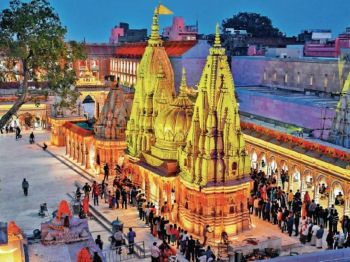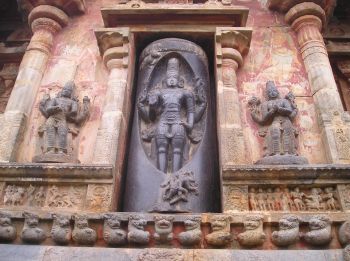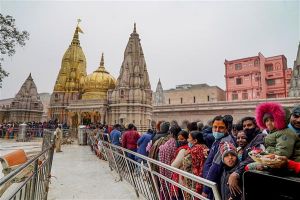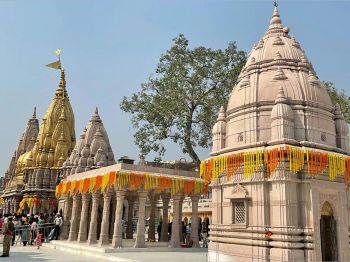One of the most important temples to Hindus is the ancient temple at Varanasi on the banks of the river Ganga. The Kashi Vishwanath Temple, which has endured the razes of several Muslim emperors and leaders, is considered the holiest of all temples in India. There is a common desire or custom among most devoted Hindus to go on a pilgrimage to Kashi at least once in their lifetime.
 Having heard a lot about this temple from songs, dance pieces, books and mythological legends, it is one of those destinations that top my ‘to-travel-to’ places.
Having heard a lot about this temple from songs, dance pieces, books and mythological legends, it is one of those destinations that top my ‘to-travel-to’ places.
Legend behind the Jyotirlinga
Located in Varanasi, Uttar Pradesh, a North Indian state, the deity in this temple is one of the 12 Jyotirlingas, forms of Lord Shiva as temples across India. There is an interesting, very popular legend behind the concept of the ‘Jyotirlinga’. As per the Puranas, Lord Brahma and Lord Vishnu had a debate over who was greater and the Supreme power. In order to test them, Lord Shiva pierced the three worlds as a huge pillar of endless light, known as the Jyotirlinga. Vishnu assumed the form of a boar and proceeded to search at the bottom of the pillar, while Brahma took on the form of a swan and flew upwards to search at the top. Neither could find the end of the massive pillar.
Reaching back, Brahma lied that he had found out the end successfully. He even showed a katuki flower as proof. Vishnu, on the other hand, decides to be honest and confesses  that he failed to find the end. Enraged with Brahma’s dishonesty, Shiva takes the fiery form of Bhairava and cuts off the fifth head of Brahma which uttered the lie. He also curses Brahma that he would never be worshiped anywhere again. As a result, to this day, you cannot find a temple in India or elsewhere that is dedicated to Lord Brahma.
that he failed to find the end. Enraged with Brahma’s dishonesty, Shiva takes the fiery form of Bhairava and cuts off the fifth head of Brahma which uttered the lie. He also curses Brahma that he would never be worshiped anywhere again. As a result, to this day, you cannot find a temple in India or elsewhere that is dedicated to Lord Brahma.
Meanwhile, Shiva praises Vishnu’s honesty and modest reply and blesses him that he would be widely worshiped as equally as Lord Shiva himself, which stands true to this day. The number of temples and shrines dedicated to Lords Shiva and Vishnu is equally distributed. The Jyotirlinga highlighted in this legend is present in 12 different sacred points across India. The Kashi Vishwanath Temple is one of them, and probably the most famous and most visited ones as well.
Destruction and re-construction
The temple at Kashi, however grand and tall it stands today, has been subject to a long painful history of destruction by Mughal rulers. Several Hindu rulers contributed to the re-construction of the demolished temple and ruined shrines. But the jaw-dropping fact that the Jyotirlinga inside the main shrine has always been intact despite all the destruction and damage symbolises the timelessness of the lingam, which draws even more devotees to the shrine.
A mosque inside a temple
Yes, you read that right. One of the biggest and most revered Hindu temples of all time has a Muslim mosque within its architecture. Emperor Aurangzeb, the son of the creator of the Taj Mahal, constructed the disputed structure of the Gyanvapi Mosque over the demolished remains of the continuously ruined Kashi temple. Even today, remnants of the Hindu temple like a statue of Shiva’s bull, Nandi can be seen in the outer walls of the mosque.

Popularity
Kashi Vishwanath Temple is so close to the hearts of ardent devotees that it attracts at least 3000 visitors a day. On special occasions, a whopping 1,000,000 devotees visit the temple to get a darshan of this ultimate deity. Imagine the crowd present there everyday!
The temple complex
Unlike the huge gopurams set in stone along with the deity inside within almost a single wall we see in most South Indian temples, the Kashi Vishwanath Temple complex is set in a lane called ‘Vishwanatha Galli’. This lane houses smaller shrines of Lord Kala Bhairava, Karthikeya, Vishnu, Ganesha, Shiva, Parvati and Shani Deva.
Importance among Hindu Devotees 
A number of most popular saints and leaders of Hinduism: Adi Shankaracharya, Ramakrishna Paramahamsa, Swami Vivekananda and Goswami Tulsidas have visited and made heir offerings to this famed temple. Many Hindus believe that a visit to the temple and a bath in the adjacent river Ganga will get oneself moksha (liberation). There is a popular belief that Shiva himself blows the mantra of salvation into the ears of people who die naturally at the Vishwanath temple.
Despite its religious importance, the Kashi Vishwanath temple is a unique structure, which has inspired the architecture of various temples across India. A visit to the temple and its surroundings would be interesting to anyone who appreciates uniqueness and timelessness. I would very much like to spend a day or two in admiration of the temple, its structure, legends and beliefs.